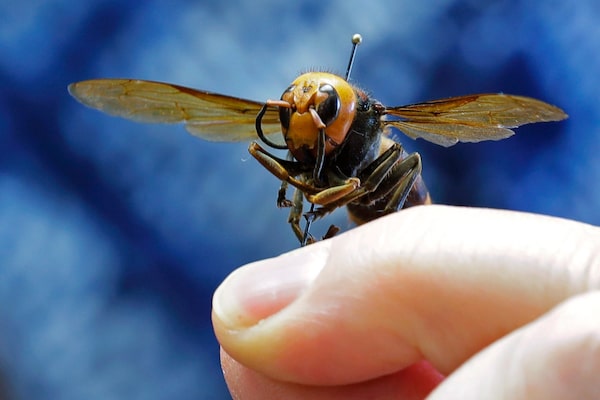
An Asian giant hornet from Japan is seen in Olympia, Wash., on May 4, 2020.Ted S. Warren/The Associated Press
An invasive species dubbed the “murder hornet,” which has prompted concerns about the potential impact on honeybees in Western Canada, has been found in British Columbia’s Fraser Valley, leading experts to believe the Asian giant hornet may have spread farther than initially thought possible.
An Asian giant hornet nest was discovered and destroyed on Vancouver Island last fall. There have also been confirmed sightings of the hornets in Blaine, Wash., and White Rock, B.C.
Meanwhile, Alberta’s provincial beekeeper has said the province is conducting risk assessments to determine the potential impact there.
B.C.'s provincial apiculturist, Paul van Westendorp, said a hornet was reported this month by a woman who saw the insect near her garden in Langley, about an hour’s drive east of Vancouver. It was dispatched with a good stomp and is now sitting in Mr. van Westendorp’s freezer awaiting lab testing.
Mr. van Westendorp said the discovery was a rude awakening. While the invasive species was initially believed to be confined to limited coastal areas, the discovery of the specimen outside Langley may indicate the Asian giant hornets have spread wider than expected.
The insects, nicknamed “murder hornets” for their ability to devastate honeybees, are considered apex predators that pose a risk to local ecosystems. The hornets are territorial and will attack if they feel their nest is threatened, and their venomous stings can hospitalize or kill people.
Experts have cautioned that the risk of the hornets establishing a foothold in North America is low and they’ve also bristled over the “murder hornets" moniker.
Asian giant hornets are forest dwellers that nest underground, making them difficult to find. It’s not clear how they arrived in British Columbia.
Mr. van Westendorp said prior to a week and a half ago, experts were under the impression the hornets were strictly confined to a couple of sightings in certain areas.
But "this is no longer just a singular situation in Nanaimo,” said Mr. van Westendorp, referring to the discovery on Vancouver Island last year. “We suddenly have to come to grips with the fact that it is not actually just confined [also] to White Rock and to Blaine.”
Mr. van Westendorp said he has yet to determine whether the specimen is a worker or a queen.
Their colonies have many expendable workers, he said, but removing the queen thwarts a nest’s development. If the dead hornet turns out to be a worker, that would mean the nest is likely still out there.
In Alberta, which is home to more than 40 per cent of Canada’s honeybees, officials are conducting detailed risk assessments in order to protect the province’s bees. The province was erring on the side of caution, acting provincial apiculturist Samantha Muirhead said this month.
Gail Wallin, executive director of the B.C. Invasive Species Council, said most invasive species go undetected until they become well-established in their environment. Ms. Wallin said it’s imperative to catch invaders such as the Asian giant hornet in the early stages in order to have a chance of fighting back.
“We don't know how many or if Asian giant hornets have established,” she said. “It's really important for Canadians to be aware of what's in their backyard, what's in the community. If it looks strange, report it.”
We have a weekly Western Canada newsletter written by our B.C. and Alberta bureau chiefs, providing a comprehensive package of the news you need to know about the region and its place in the issues facing Canada. Sign up today.